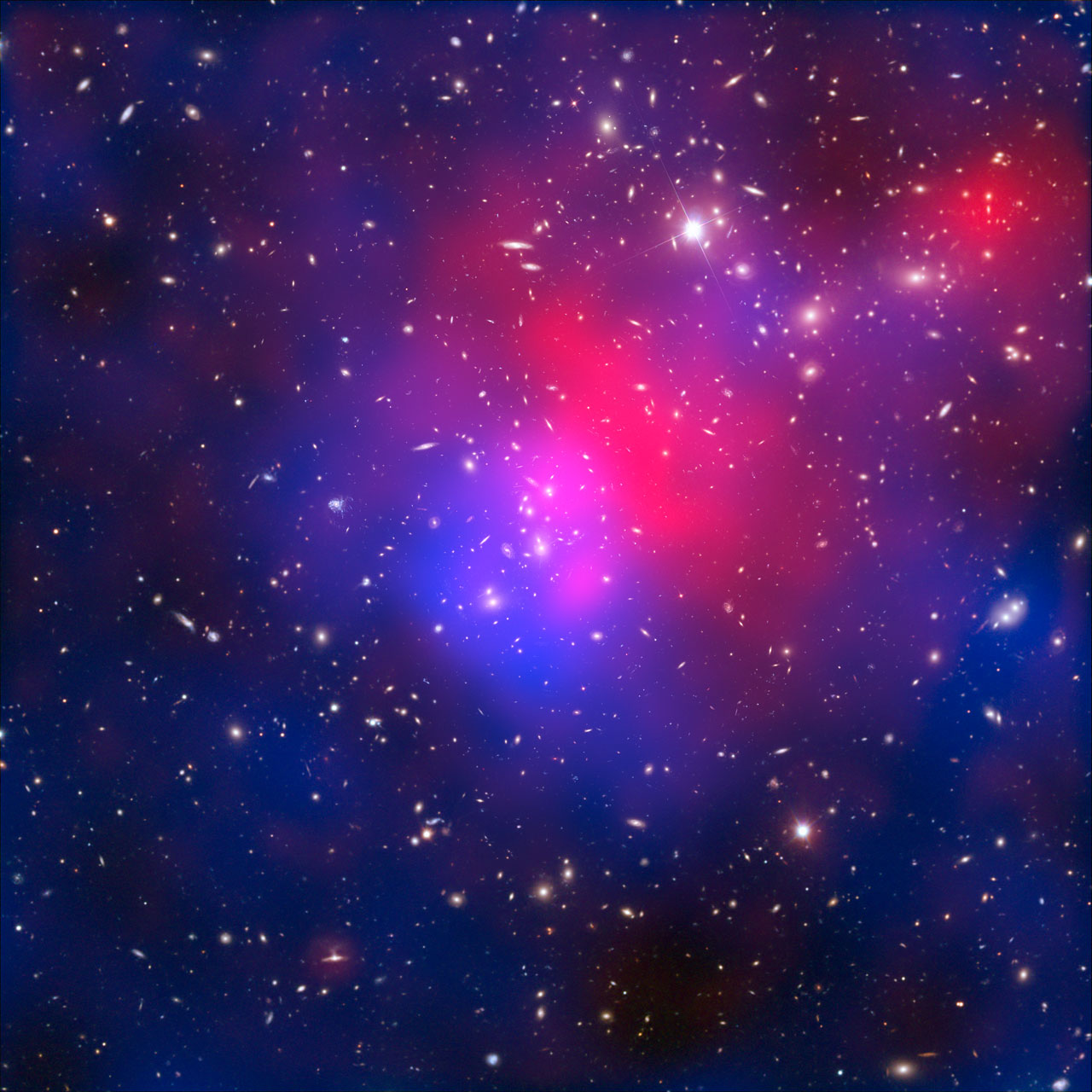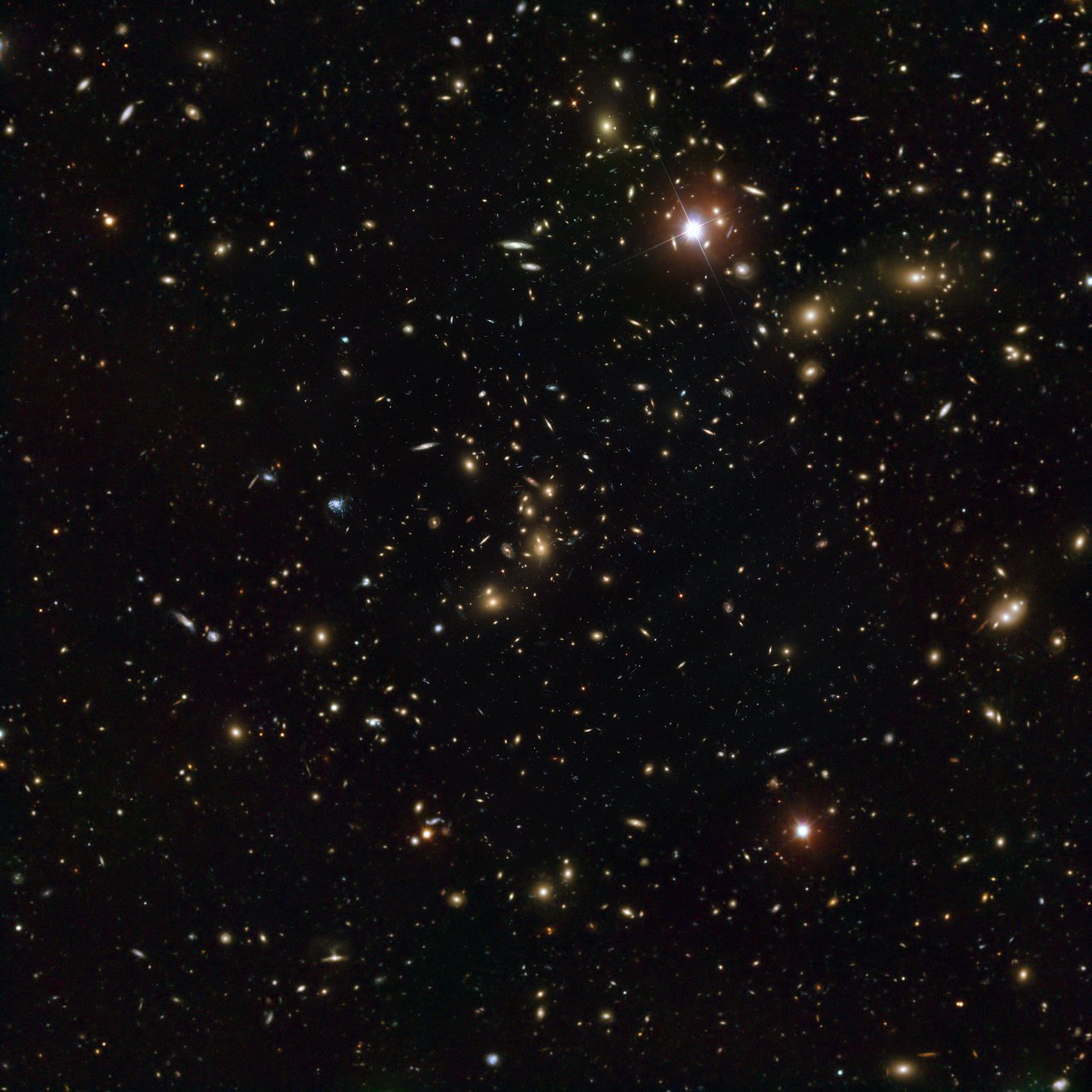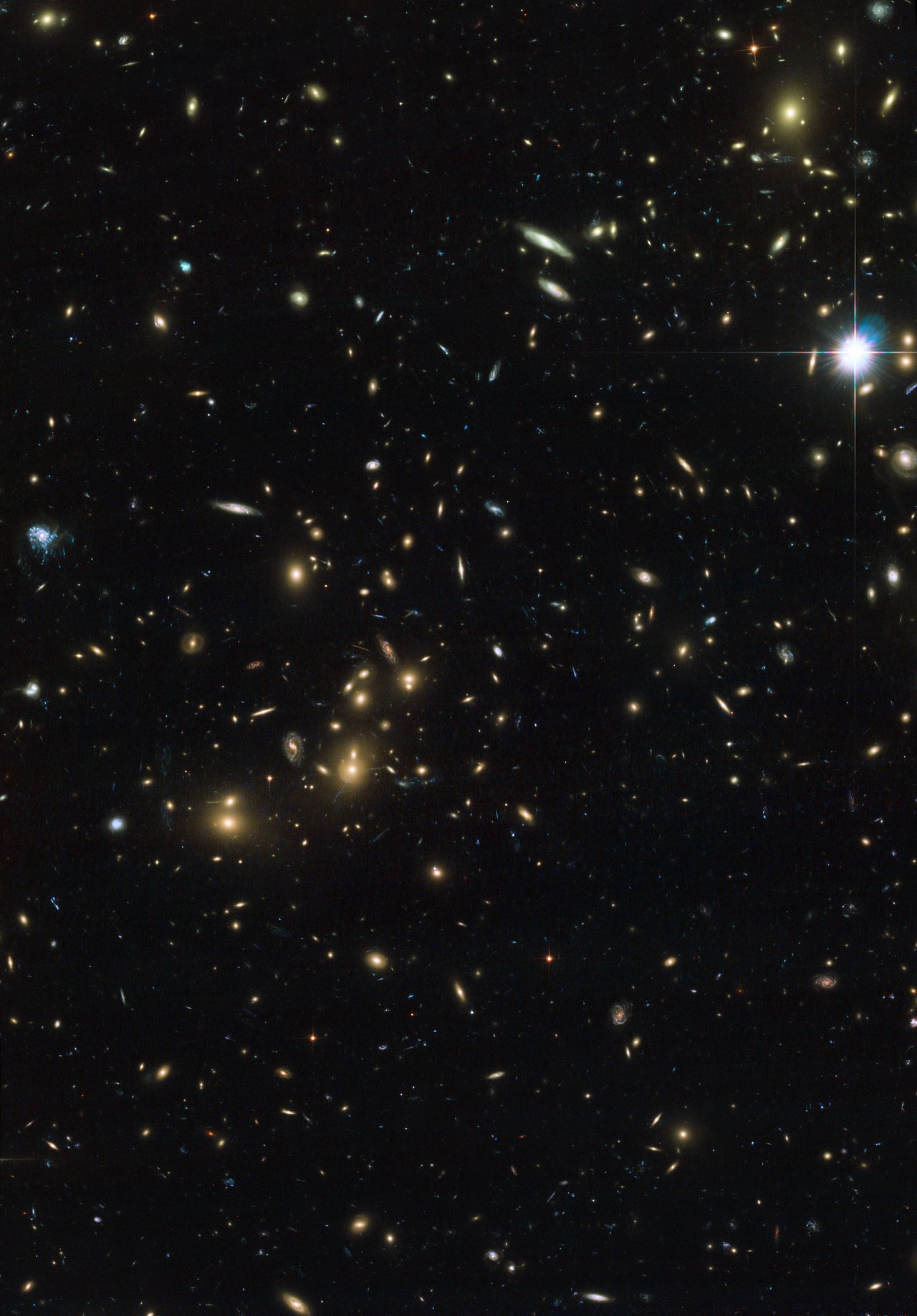NASA STSci | ESA HEIC | ESO VLT | 2011 June 22
This image combines visible light exposures of galaxy cluster Abell 2744 taken by the NASA/ESA Hubble Space Telescope and the European Southern Observatory’s Very Large Telescope, with X-ray data from NASA’s Chandra X-ray Observatory and a mathematical reconstruction of the location of dark matter.
The galaxies in the cluster, while they are the only part that is visible in the optical part of the spectrum, actually only provide around 5% of the mass in the cluster.
Hot intracluster gas (shown in pink, and responsible for around 20% of the mass in the cluster) is visible through its X-ray emissions, observed by NASA’s Chandra satellite.
The blue overlay shows a map of the mass in the cluster. This is reconstructed based on detailed analysis of the way that the cluster bends light from galaxies in the distant background. Evidence of this light bending can be seen in arc-like distortions in parts of this image. Since dark matter makes up the lion’s share of mass in the cluster — around 75% — this blue overlay reveals the location of the otherwise invisible dark matter.
Analysis of this data has allowed scientists to observe some strange phenomena in Abell 2744, including a pocket of dark matter with no gas or galaxies, and a clump of galaxies with no associated gas. Astronomers believe that Abell 2744 formed from the simultaneous pile-up of at least four separate clusters.
Zoomable Image
Abell 2744: Pandora's Cluster RevealedA team of scientists has studied the galaxy cluster Abell 2744, nicknamed Pandora’s Cluster. They have pieced together the cluster’s complex and violent history using telescopes in space and on the ground, including ESO’s Very Large Telescope and the Hubble Space Telescope. Abell 2744 seems to be the result of a simultaneous pile-up of at least four separate galaxy clusters and this complex collision has produced strange effects that have never been seen together before.
When huge clusters of galaxies crash together, the resulting mess is a treasure trove of information for astronomers. By investigating one of the most complex and unusual colliding clusters in the sky, an international team of astronomers has pieced together the history of a cosmic crash that took place over a period of 350 million years.
Julian Merten, one of the lead scientists for this new study of cluster Abell 2744, explains: “Like a crash investigator piecing together the cause of an accident, we can use observations of these cosmic pile-ups to reconstruct events that happened over a period of hundreds of millions of years. This can reveal how structures form in the Universe, and how different types of matter interact with each other when they are smashed together.”
“We nicknamed it Pandora’s Cluster because so many different and strange phenomena were unleashed by the collision. Some of these phenomena had never been seen before,” adds Renato Dupke, another member of the team.
Abell 2744 has now been studied in more detail than ever before by combining data from ESO’s Very Large Telescope (VLT), the Japanese Subaru telescope, the NASA/ESA Hubble Space Telescope, and NASA’s Chandra X-Ray Observatory.
The galaxies in the cluster are clearly visible in the VLT and Hubble images. Although the galaxies are bright they make up less than 5% of the mass there. The rest is gas (around 20%), which is so hot that it shines only in X-rays, and dark matter (around 75%), which is completely invisible. To understand what was going on in the collision the team needed to map the positions of all three types of matter in Abell 2744.
Dark matter is particularly elusive as it does not emit, absorb or reflect light (hence its name), but only makes itself apparent through its gravitational attraction. To pinpoint the location of this mysterious substance the team exploited a phenomenon known as gravitational lensing. This is the bending of light rays from distant galaxies as they pass through the gravitational fields present in the cluster. The result is a series of telltale distortions in the images of galaxies in the background of the VLT and Hubble observations. By carefully plotting the way that these images are distorted, it is possible to map quite accurately where the hidden mass — and hence the dark matter — actually lies.
By comparison, finding the hot gas in the cluster is simpler as NASA’s Chandra X-ray Observatory can observe it directly. These observations are not just crucial to find out where the gas is, but also to show the angles and speeds at which different components of the cluster came together.
When the astronomers looked at the results they found many curious features. “Abell 2744 seems to have formed from four different clusters involved in a series of collisions over a period of some 350 million years. The complicated and uneven distribution of the different types of matter is extremely unusual and fascinating,” says Dan Coe, the other lead author of the study.
It seems that the complex collision has separated out some of the hot gas and dark matter so that they now lie apart from each other, and from the visible galaxies. Pandora’s Cluster combines several phenomena that have only ever been seen singly in other systems.
Near the core of the cluster is a “bullet”, where the gas of one cluster collided with that of another to create a shock wave. The dark matter passed through the collision unaffected.
In another part of the cluster there seem to be galaxies and dark matter, but no hot gas. The gas may have been stripped away during the collision, leaving behind no more than a faint trail.
Even odder features lie in the outer parts of the cluster. One region contains lots of dark matter, but no luminous galaxies or hot gas. A separate ghostly clump of gas has been ejected, which precedes rather than follows the associated dark matter. This puzzling arrangement may be telling astronomers something about how dark matter behaves and how the various ingredients of the Universe interact with each other.
Galaxy clusters are the biggest structures in the cosmos, containing literally trillions of stars. The way they form and develop through repeated collisions has profound implications for our understanding of the Universe. Further studies of the Pandora’s Cluster, the most complex and fascinating merger yet found, are in progress.
Credit: NASA, ESA, ESO, & D. Coe (STScI)/J. Merten (Heidelberg/Bologna)
NASA SAO CXC | 2011 June 22
Creation of cosmic structure in the complex galaxy cluster merger Abell 2744 - J Merten et alOne of the most complicated and dramatic collisions between galaxy clusters ever seen is captured in this new composite image. This collision site, known officially as Abell 2744, has been dubbed "Pandora's Cluster" because of the wide variety of different structures seen. Data from NASA's Chandra X-ray Observatory are colored red, showing gas with temperatures of millions of degrees. In blue is a map showing the total mass concentration (mostly dark matter) based on data from the Hubble Space Telescope (HST), the European Southern Observatory's Very Large Telescope (VLT), and the Japanese Subaru telescope. Optical data from HST and VLT also show the constituent galaxies of the clusters.[attachment=0]a2744_labeled.jpg[/attachment][/i]
The "core" region (rollover mouse for labels) shows a bullet-shaped structure in the X-ray emitting hot gas and a separation between the hot gas and the dark matter. (As a guide, local peaks in the distribution of hot gas and overall matter in the different regions are shown with red and blue circles respectively). This separation occurs because electric forces between colliding particles in the clouds of hot gas create a friction that slows them down, while dark matter is unaffected by such forces.
In the Northwest ("NW") region, a much larger separation is seen between the hot gas and the dark matter. Surprisingly, the hot gas leads the "dark" clump (mostly dark matter) by about 500,000 light years. This unusual configuration may require a slingshot scenario, as suggested previously by scientists, to fling the hot gas ahead of the dark matter during an earlier interaction. In the North ("N") and the West ("W") two additional examples of hot gas separated from dark matter may be visible. The latter appears to exhibit the largest separation seen to date between hot gas and dark matter.
The authors of this study retraced the details of the collision, and deduce that at least four different galaxy clusters coming from a variety of directions were involved. To understand this history, it was crucial to map the positions of all three types of matter in Abell 2744. Although the galaxies are bright, they make up less than 5% of the mass in Abell 2744. The rest is hot gas (around 20%) visible only in X-rays, and dark matter (around 75%), which is completely invisible.
Dark matter is particularly elusive as it does not emit, absorb or reflect light, but only makes itself apparent through its gravitational attraction. To pinpoint the location of this mysterious substance the team used a phenomenon known as gravitational lensing. This is the bending of light rays from distant galaxies as they pass through the gravitational field present in the cluster. The result is a series of telltale distortions in the images of galaxies in the background of optical observations. By carefully plotting the way that these images are distorted, a map is constructed of where the mass -- and hence the dark matter -- actually lies (shown in blue).
Galaxy clusters are the largest gravitationally bound objects in the Universe and have become powerful tools in cosmology studies. Further studies of Abell 2744 may provide a deeper understanding of the way that these important objects grow and provide new insight into the properties of dark matter.
- arXiv.org > astro-ph > arXiv:1103.2772 > 14 Mar 2011 (v1), 20 Jun 2011 (v2)
Click to play embedded YouTube video.
Click to play embedded YouTube video.
Wired Science | Lisa Grossman | 2011 June 22
Strange Galaxy Cluster Born From Huge Cosmic Crash
Space.com | 2011 June 22
A Four Cluster Pile-Up
Universe Today | Jason Major | 2011 June 23
Opening the lid on Pandora’s Cluster
Discover Blogs | Bad Astronomy | 2011 June 24



